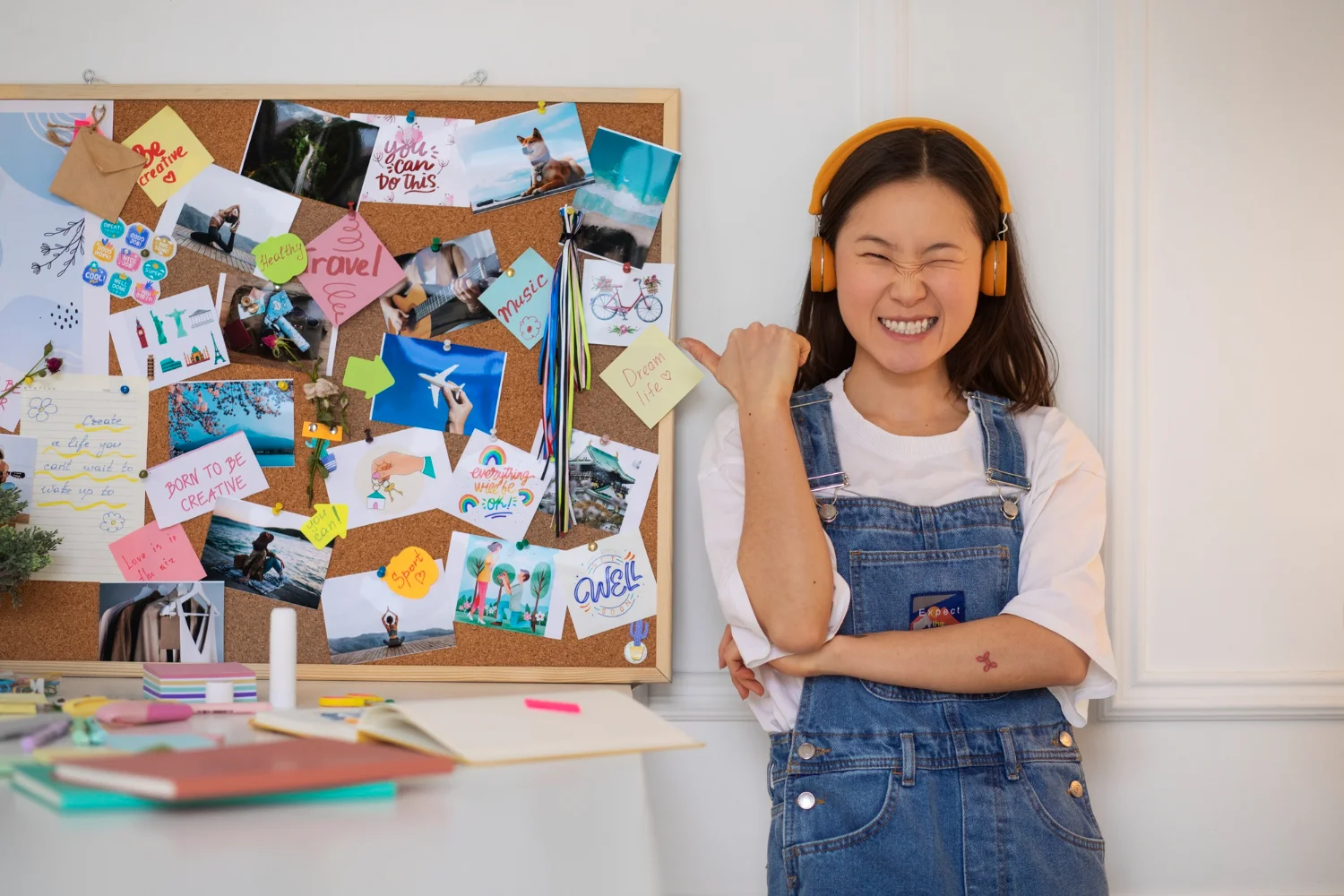
Let me guess. You’ve tried vision boards before, got super excited for about three days, spent way too much time perfecting every tiny detail, then completely forgot it existed until you found it under a pile of laundry six months later.
Yeah, me too.
Here’s the thing though – vision boards can actually be amazing for ADHD brains. We just need to stop trying to make them work like neurotypical brains and start making them work like our brains. You know, the ones that get distracted by shiny things, forget what we were doing mid-sentence, and somehow manage to hyperfocus on organizing our sock drawer at 2 AM.
Time to make vision boards that actually stick around longer than your latest hobby obsession.
Why Traditional Vision Boards Don’t Work for ADHD Brains
Let’s be real for a hot second. Most vision board advice is basically designed to torture people like us:
- “Spend hours carefully cutting out magazine images” → Meanwhile, we got distracted by an article about penguins and forgot what we were doing
- “Create a detailed, complex collage” → Our brains see that busy mess and immediately nope out
- “Look at it every single day” → What vision board? Oh right, it’s behind that stack of books I meant to read
- “Be patient and consistent” → nervous ADHD laughter
The problem isn’t that we’re bad at goals. The problem is we’re trying to use tools designed for brains that work completely differently than ours.
The ADHD Vision Board Advantage
But here’s what nobody tells you – ADHD brains are actually vision board GOLD. Seriously. We’re naturally visual thinkers, we love novelty, we get excited about possibilities, and when something clicks? We go ALL IN.
We just need to work with our ADHD, not against it.
6 Visual Goal Setting Tips That Actually Work for ADHD Brains

1. Make It Dopamine-Friendly (AKA: The Instant Gratification Method)
Your ADHD brain needs that sweet, sweet dopamine hit to stay engaged. So let’s give it what it wants.
Instead of this: One giant vision board you work on for hours Try this: Mini vision boards you can finish in 15 minutes
How to dopamine-hack your vision board:
- Use sticky notes instead of cutting and gluing (instant satisfaction!)
- Make one tiny board per goal (more completion wins!)
- Use bright, colorful markers and fun supplies
- Set a timer for 10-15 minutes max
- Celebrate when you finish each mini-board like you just won the lottery
Real example: Instead of creating one massive “life goals” board, I made separate index cards for “get better at cooking,” “learn guitar,” and “organize my closet.” Each one took 10 minutes, I felt accomplished three times instead of once, and I actually finished them all.
2. Keep It STUPID Simple (The ADHD Motto)
Complexity is the enemy of the ADHD brain. We start with grand plans and end up overwhelmed by our own ambition.
The STUPID Simple Rule:
- Small images only
- Three items max per board
- Use words if images don’t make sense
- Plain backgrounds (no fancy patterns)
- Immediate visual impact
- Done is better than perfect
Visual clutter = mental clutter. If your vision board looks like a Pinterest explosion, your ADHD brain will take one look and peace out faster than you can say “squirrel.”
| ADHD Brain Killer | ADHD Brain Winner |
|---|---|
| 47 tiny images crammed together | 3 clear, big images with space |
| Fancy fonts and decorations | Simple, bold text |
| Every color of the rainbow | 2-3 main colors max |
| Complex artistic layouts | Grid or line layout |
3. Location, Location, Location (Put It Where You Actually Are)
That beautiful vision board hanging in your “home office” (AKA the room where you dump stuff)? Yeah, you’re never going to see it.
ADHD-friendly locations:
- Bathroom mirror (you’re there every day anyway)
- Coffee maker area (morning routine trigger)
- Inside your planner or notebook
- Phone wallpaper (always with you)
- Fridge door (but not buried under 47 takeout menus)
Pro tip: Take a photo of your vision board and make it your phone lock screen. Every time you check your phone (which, let’s be honest, is approximately 847 times a day), you’ll see your goals.
4. Make It Changeable (Embrace Your Need for Novelty)
Your ADHD brain gets bored. This isn’t a character flaw, it’s literally how you’re wired. So instead of fighting it, plan for it.
Ways to keep it fresh:
- Use a dry erase board or magnetic board
- Sticky notes that you can move around
- Digital vision board on your tablet
- Seasonal updates (every 3 months max)
- Add one new element each month
Story time: I used to feel guilty about changing my vision boards. Like, shouldn’t I stick with my goals? Then I realized – my core goals stayed the same, but the way I wanted to achieve them evolved. Now I update mine every season and it feels like getting a new toy instead of admitting failure.
5. Body Double It (Make It Social, But Not Overwhelming)
ADHD brains often work better with body doubling – having someone else around while you work. But vision board parties? Too much pressure, too much comparison, too much everything.
Better body doubling options:
- Video call a friend while you both work on yours
- Work on it while someone else does their own project nearby
- Join an online ADHD group doing vision boards together
- Ask a friend to sit with you for 20 minutes while you create
The key: They’re there for company and accountability, not to judge your artistic skills or tell you their opinions about your dreams.
6. Connect It to Your Hyperfocus Powers
When we ADHD folks get interested in something, we don’t just get interested – we become temporary experts who research everything and buy all the supplies at 3 AM.
How to use this superpower:
- Pick goals that genuinely excite you (not “should” goals)
- Let yourself research and plan for a bit
- Set a timer to prevent falling down research rabbit holes
- Use your hyperfocus energy to create, not just consume
But also: Set boundaries on the research phase. Give yourself one day to look up vision board ideas, buy supplies, and get inspired. Then create the next day while the excitement is still fresh.
The ADHD Vision Board Reality Check
Let’s get real about what to expect:
You will probably:
- Forget about it sometimes (that’s normal)
- Want to change it more often than “experts” recommend (also normal)
- Make some that don’t work out (totally fine)
- Get distracted while making it (embrace it)
- Have days when you ignore it completely (human)
You will NOT:
- Be perfect at this (nobody is)
- Look at it religiously every day (unrealistic expectation)
- Manifest everything exactly as pictured (life doesn’t work that way)
- Ruin your chances if you mess up (you get infinite do-overs)
Your ADHD Vision Board Starter Kit
Ready to try this? Here’s your super simple starter approach:
Grab:
- One piece of paper (any size)
- 3 sticky notes OR 3 magazine cutouts OR 3 printed photos
- A marker or pen
Do this:
- Set timer for 15 minutes
- Pick ONE area of your life
- Find 3 images that make you feel excited about that goal
- Stick them on the paper with space between
- Write one word under each image
- Put it somewhere you’ll actually see it
- Take a photo with your phone as backup
- Celebrate because you just finished something!
That’s it. Seriously. Done is better than perfect, and simple is better than complicated.
When Your ADHD Brain Gets Bored

It’s going to happen. Your vision board will start feeling stale, you’ll forget to look at it, or you’ll decide you hate everything about it. This doesn’t mean you failed – it means you’re human with ADHD.
When boredom hits:
- Change the location
- Update one image
- Add a new color
- Make it smaller or bigger
- Start fresh (it’s okay!)
Remember: The goal isn’t to create the perfect vision board that lasts forever. The goal is to have a tool that keeps your dreams visible and your ADHD brain engaged.
The Bottom Line
Your ADHD brain isn’t broken, and you don’t need to force yourself into neurotypical goal-setting methods. You need tools that work with your natural wiring – tools that are visual, flexible, simple, and yes, a little bit fun.
Will you be perfect at this? Nope. Will your vision board look like the ones on Pinterest? Probably not. Will it help you stay connected to your goals in a way that actually works for your brain? Absolutely.
So grab some sticky notes, set that timer, and let’s make a vision board that your ADHD brain will actually want to stick with. Because you deserve goals that feel achievable, dreams that stay visible, and a process that doesn’t make you want to hide under a blanket.
You’ve got this. One simple, dopamine-friendly step at a time.
P.S. – If you made it to the end of this post without getting distracted, you’re already winning at focus today. Give yourself credit for that.





Leave a Reply